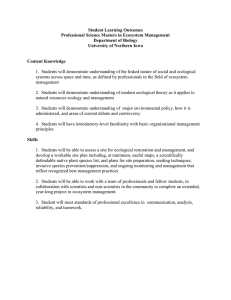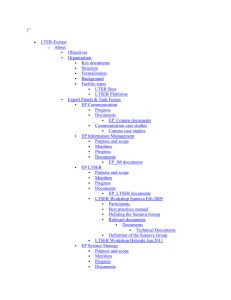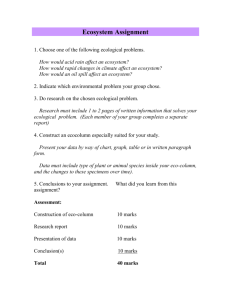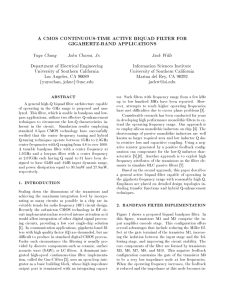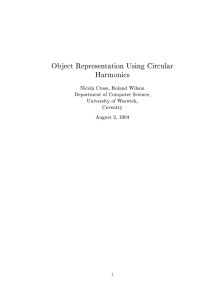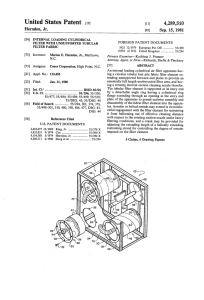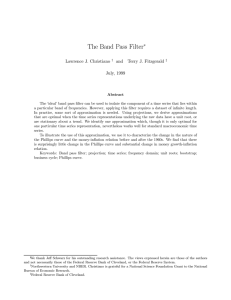Human Dimensions of Ecological Forecasting
advertisement
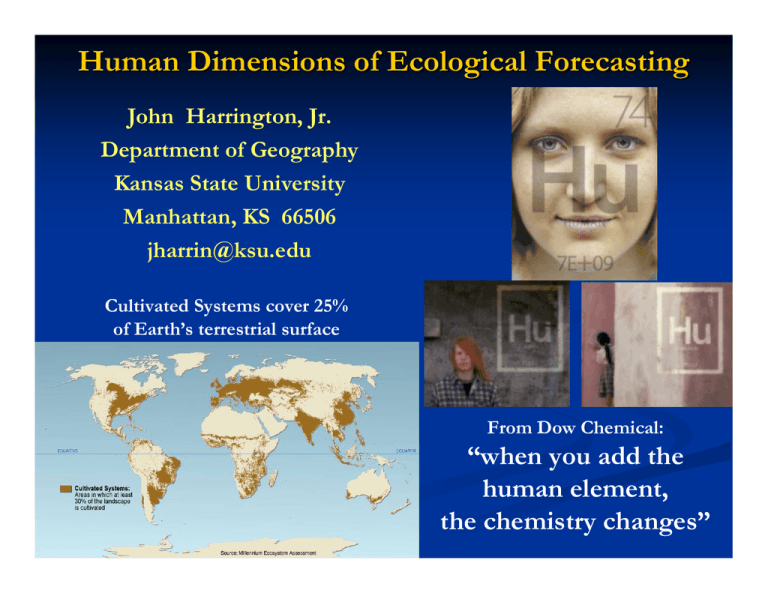
Human Dimensions of Ecological Forecasting John Harrington, Jr. Department of Geography Kansas State University Manhattan, KS 66506 jharrin@ksu.edu Cultivated Systems cover 25% of Earth’s terrestrial surface From Dow Chemical: “when you add the human element, the chemistry changes” “Together, cropland and pastures have become one of the largest terrestrial biomes on the planet, rivaling forest cover in extent and occupying ~ 40% of the land surface” (Foley et al., 2005) The Anthropocene 6.7 billion people today Another 2.5 billion more by 2050 Foley et al., SCIENCE 309, 2005 Stephen Carpenter : “We are now living in a no analog World.” The Bottleneck In his 2002 book, The Future of Life, E.O. Wilson uses a metaphor (“the bottleneck”) to describe the current situation – a period of maximum stress on natural resources and human ingenuity resulting from overpopulation and over-consumption. Land use change and related socioeconomic feedbacks are important drivers - that change biodiversity and ecological systems There is a need for both curiosity-driven and applied research on central US land change What might be the result of a policy shift to support and subsidize cellulosic ethanol? Infrastructure development goals for the human dimensions component: - Add a new social science faculty member - Help create a multi-disciplinary atmosphere for the development of new research questions - Meetings and more meetings - Increase our collective understanding of the human dimensions of land change - Dr. Ruth DeFries in Sept 2006 (Provost-level funding) - Train students in human dimensions aspects of global change and ecological forecasting A period of rapid and unprecedented global change: Types, Rates, and Magnitudes of Change Human Dimensions: Accomplishments To-Date Bibliography development – Summer 2006 GRA (Mary Dobbs) Geog seminar – Summer 2006 “Climate and Vulnerability” (12 students) Geog seminar – Fall 2006 Social Science Aspects Of Land Change Science; What Factors Influence A Change In Land-use Or Land-cover? “Land Change Science” (8 students) Poster presentation at LTER ASM – Sept 2006 Authors = Harrington (geog), Middendorf (soc), Blair (biol), and Dodds (biol) “Linking the Konza Prairie LTER Program to Coupled Human and Natural Systems Research in the Flint Hills” Two new human dimensions projects as a result of conversations at the ASM Human Dimensions: Accomplishments To-Date Approval of and search for new faculty “Land Change Science” “geographer with research interests in the land change science component of human dimensions of global and regional change” Two new faculty were hired from the pool of applicants: Dr. Kendra McLauchlan (now a post-doc at Dartmouth) PhD from Minnesota Brings paleo, soils, agriculture, and ecological perspectives Dr. Marcellus Caldus (now finishing his 2nd PhD at MSU) PhD in Applied Economics from Univ. of São Paulo Brings econ., remote sensing & GIS, and ag. applications perspectives Both have extensive experience doing field work on land change Proof of concept Agrarian Transition KNZ LTER project – a look at the environmental history related to agricultural changes in the Flint Hills Designing Resilience Book chapter and journal article Modest funding from Agrarian Transition pool of dollars Working with Ken Sylvester (Univ of Michigan, environmental historian) Beau Burkitt (GRA funded using Ecoforecasting dollars) Social science and humanistic researchers using hydrologic models and GIS to examine how changes in land management with impact water quality, biodiversity, and economic returns Ecosystem Services from Working Lands Funding from LTER Network Office LTER social/ecological project led by Scott Swinton (MSU Ag. Econ & KBS) Judd Patterson (GRA funded using Ecoforecasting dollars) Inventory ecosystem services at each of 6 sites and develop a typology of ecosystem services Examine how human managers can enhance ecosystem services and generate hypotheses about factors limiting the provision of ecosystem services Additional extramural funding NSF HSD competition “Collaborative Research: Understanding Social-ecological Dynamics In Grassland Ecosystems Of North And South America” Joint Global Change Research Institute at Battelle, K-State, Universidad Nacional de Córdoba, Argentina Support from Kansas NASA Space Grant Supplemental funding to support GRAs (travel and GRA stipends) Space grant funding for ½ of a GRA for this coming year This summer: Unstructured interviews of stakeholders throughout the study area Goals = to find out what types of information triggers a change in land-use or land cover, and what information sources are relied upon 3 GRAs (Beau Burkitt, Judd Patterson, and Matt Gerike) Work on publication(s) from the Northern Flint Hills Ecosystem Services effort Additional watershed modeling for the Designing Resilience effort
